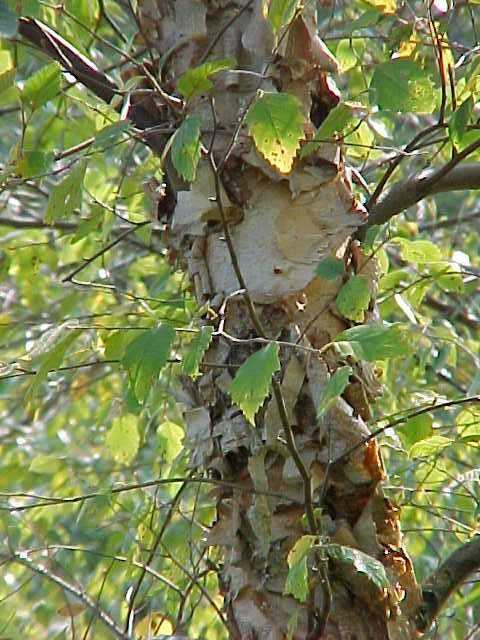River birch (Betula nigra ‘Cully’ HERITAGE)
River birch
Betula nigra, commonly called river birch, is a vigorous, fast-growing, medium-sized, Missouri native deciduous tree which occurs on floodplains, swampy bottomlands and along streams throughout the State. In cultivation, it can be trained as either a single trunk or multi-trunked tree. As a single trunk tree, it develops a pyramidal habit when young, but matures to a more rounded shape typically growing 40-70′ tall. Multi-trunked trees form a more irregular crown and are generally considered to be the superior growth habit for this species. Salmon-pink to reddish brown bark exfoliates to reveal lighter inner bark. Leathery, diamond-shaped, medium to dark green leaves (5-5″ long) with doubly toothed margins turn yellow in fall. Monoecious flowers appear in drooping, brownish male catkins and smaller, upright, greenish female catkins.
Genus name is the Latin name for birch.
Specific epithet means black.
‘Cully’, often sold as HERITAGE, is a vigorous, fast-growing, medium-sized tree which can be grown as either a single trunk or multi-stemmed tree and features salmon-cream to brownish bark which exfoliates to reveal a creamy white inner bark that can be nearly as white as the white-barked birches. it was found growing in St. Louis, Missouri by Earl Cully. Although often sold as ‘Heritage’ it appears that the correct cultivar name is ‘Cully’. The plant is being sold under the trade name HERITAGE. U.S. Plant Patent #4,409 issued April 24, 1979.

Easily grown average, medium to wet soils in full sun to part shade. River birch is perhaps the most culturally adaptable and heat tolerant of the birches. Prefers moist, acidic, fertile soils including semi-aquatic conditions, but also tolerates drier soils. Consider using soaker hoses and bark mulches to keep the root zones cool and moist. Adapts well to heavy clay soils of Missouri and will tolerate poor drainage. Avoid pruning in spring when the sap is running.
| Hardiness zone | 4 - 9 |
| Sun light | Full sun to part shade |
| Water | Medium to wet |
| Maintenance | Low |
One of the most disease-free birches. Most species of birch grow best in cool, northern climates, but do not adapt well to the hot summers of USDA Zones 5-9 and can be short-lived therein. Weakened birches become vulnerable to the bronze birch borer which typically infects and kills birches stressed by summer heat and humidity. River birches are Missouri natives that are naturally adapted to the climate and are extremely resistant to birch borer. Although river birches have some susceptibility to aphids, leaf miner and iron chlorosis in high pH soils, these problems are somewhat minor in comparison to the birch borer.
‘Cully’ is extremely resistant to the bronze birch borer and also has good resistance to leaf spot diseases.
Specimen or small groupings for lawns, parks and commercial properties, and, in particular, for wet soils along ponds, streams or in low spots. Good choice for the St. Louis area and generally a good substitute for the paper birch in the hot and humid areas of USDA Zones 5-9.
| Common name | River birch |
| Botanical name | Betula nigra 'Cully' HERITAGE |
| Plant type | Tree |
| Family | Betulaceae |
| Hardiness zone | 4 - 9 |
| Water | Medium to wet |
| Maintenance | Low |
| Flower color | Brown (male) and green (female) |
| Flowering period | April - May |
| Height | 40 - 70 ft. |
| Width | 40 - 60 ft. |